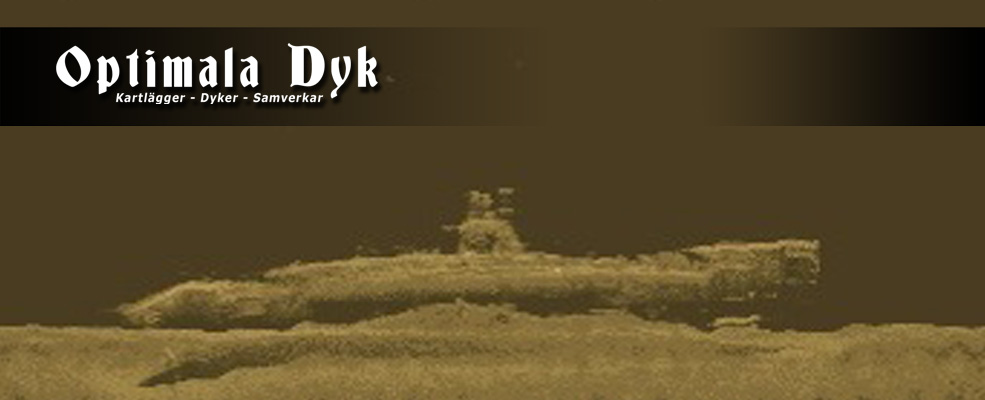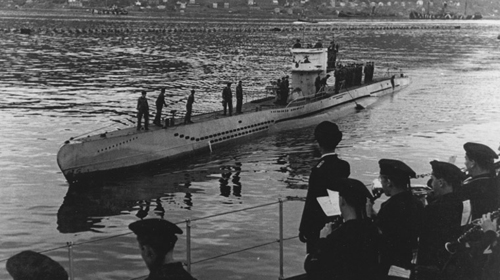
In the Kattegat, there are still several submarines from World War II on the ocean floor. One of these is the German U-251 which is located in the middle of the Kattegat, near the island of Anholt, at a depth of 35 m.
U-251 was built in Bremen in 1941 and was a type VIIC submarine. (The same type who figures in the famous German war film "Das Boot") In April 1942 the U-251 left Germany under the command of Captain Heinrich Timm. They sailed up to northern Norway where the port of Kirkenes was used as a base for operations.
Due to the limitation of speed and time that these submarines could be submerged, they usually sailed on the surface, using their diesel engines. Then as a convoy of ships was spotted the tactic was to follow it until more submarines had joined in the hunt and when it was dark the submarines could make an attack together against the convoy.
U-251 sinks S/S Jutland
On patrol in early May 1942 the men onboard U-251 spotted a British convoy, PQ15, which was heading towards Russia with military equipment. The convoy was followed as more German units were summoned. Shortly before midnight on May 3 the Luftwaffe attacked the convoy and managed to sink two vessels, S/S Botavon and Cape Corso. The convoy opened fire against the attackers and the British succeeded in shooting down two German aircraft which crashed into the sea. Shortly after midnight the U-251 attacked: Three torpedoes were fired, and moments later, the crew could hear the torpedoes explode and the British cargo ship S/S Jutland sank.
On board the British ship HMS Leda, this was part of the convoy, spotted U-251 as the submarine dove after its attack. Leda headed straight towards the U-251 and a few minutes later dropped four depth charges, set to detonate at between 40 and 80 m deep, were dropped against the German submarine. After having dropped the depth charges HMS Leda lost contact with the submarine and an hour later the search was aborted and the ship returned to the convoy in the belief that they had either sunk or damaged the submarine. Aboard U-251 the crew had heard the depth charges fall and explode, but far enough away for them to get away and a quarter to four in the morning, the threat was considered to be over and the submarine surfaced.
A second victim
In early July 1942, U-251 was based in Harstad in northern Norway as the crew got their orders for a new patrol. The mission was to find targets along with five other submarines. Together they represented the wolf pack Eisteufel, "Ice devils".
On July 10 they attacked convoy PQ17, one of the Second World War’s most famous convoys. The convoy consisted of about 40 ships due to Russia with military equipment. Almost all ships in the convoy were sunk. A quarter to one in the morning the U-251 fired a well aimed torpedo against the cargo ship El Capitán, which sunk as a result of injuries sustained when the torpedo exploded.
U-251 is sunk close to Anholt
On the 19th of April 1945, U-251, now under the command of Franz Säck, was in the Kattegat along with U-2502 and U-2335 and M-403 on their way from Kiel to Norway. In the afternoon several British Mosquito and Mustang aircraft were spotted as they were approaching the ships and soon after the U-boots were under attack. U-2502 and U-2335 dove and escaped the attack with only minor injuries and later they arrived in Norway after a short stop in Aarhus for repair. U-251 and M-403 were not as lucky.
U-251 engaged the aircraft with its 2 cm gun at the same time as the attacking planes scored hits on the u-boot both fore and aft on which the ship started taking in water. At this time most of the submarine crew was out on the deck and the 3.7 cm gun was operated in addition to the 2 cm gun. Some of the crew took cover behind the tower. The British bombers scored three new hits on U-251 and this was the end for the u-boot. Order to abandon ship was given.
In the cold water
The crew from U-251 was now in the cold water. The water temperature was barely five degrees. M-403 which was only a short distance away came to rescue the crew but the ship was also hit by the bombers and sunk. After lying in the water for 20 minutes the first of the crew died from the cold water. After 2.5 hours in the water there were only four survivors of the crew. They saw U-2502 surface and called for its attention. The four survivors were taken aboard the submarine and its crew searched for more survivors but found only scattered wreckage and corpses floating in the water.
Two British aircraft make an emergency landing in Sweden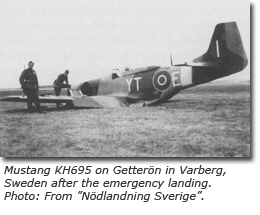
During the battle with the Germans, three aircraft were hit by German anti aircraft fire. One Mosquito aircraft managed to make an emergency landing in Denmark. One Mustang aircraft, KH695, which acted as escort to the Mosquitos, made an emergency landing on Getterön outside Varberg in Sweden. The pilot escaped unharmed.
15 min later a Mosquito aircraft, RS612, flew in over Halmstad in Sweden. Distress signals were sent out as the plane took a few turns over the town. The aircraft passed over the beach in Tylösand and soon after it made an emergency landing on the military airfield of F14 in Halmstad. The aircraft was penetrated with multiple bullet holes and the right propeller was shot to pieces. The two crewmen escaped unharmed and was glad to have landed in neutral Sweden. The crew men reported that the aircraft had been damage when they attacked German submarines in the Kattegat.
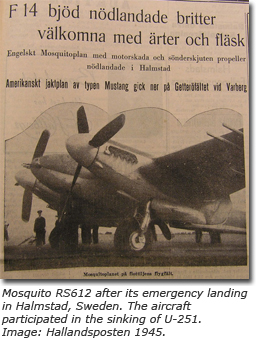
The day after it said in the local newspaper, Hallandsposten, that the two crew members were 25 years old and that they, after their emergency landing, had been given the Swedish army’s best food: peas soup with pork. The newspaper also said that the two Britons thought the food tasted excellent.
The wreck of U-251
Today, the wreck of U-251 stands right on the bottom outside the island of Anholt. The u-boot is relatively intact even if you clearly s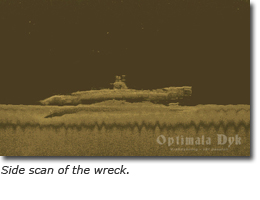 ee traces of the battle when it went under.
ee traces of the battle when it went under.
The wreck is 67 m long and the width is 6 m. As the bottom is pretty hard the wreckage has not sank too far down into the bottom which allows the propeller and rudder at the stern to be seen very clearly. There are some holes to peek into at various places on the wreck. For example one can see straight down into the submarine at the tower.
